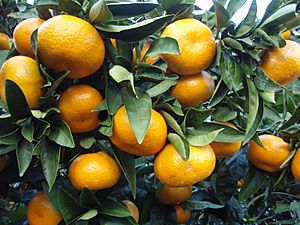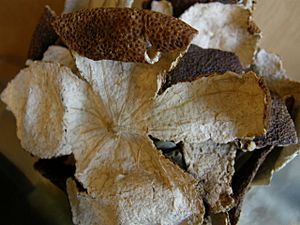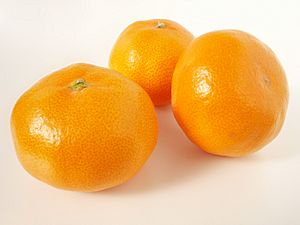Citrus unshiu facts for kids
Quick facts for kids Citrus unshiu |
|
|---|---|
 |
|
| Scientific classification | |
| Genus: |
Citrus
|
| Species: |
unshiu
|
The Satsuma orange (also known as Citrus unshiu) is a super sweet and easy-to-peel type of citrus fruit. It has very few seeds, or sometimes none at all! You might also hear it called miyagawa mandarin, unshu mikan, cold hardy mandarin, satsuma mandarin, satsuma orange, naartjie, or tangerine.
The name Citrus unshiu comes from Unshu (Wenzhou), a place in China famous for its mandarin oranges. For a long time, people thought this fruit came from China. However, recent studies in the 2010s suggest it actually started in Japan. It seems to have been created in the Satsuma Province in Japan, from a mix of two other citrus types: Kishu and Kunenbo. The Satsuma orange became very popular in Japan after the country started to modernize in the Meiji period. It was first brought to Western countries from the Satsuma region of Japan in 1878.
Contents
What are the Satsuma's names?
In China, the Satsuma is called wēnzhōu mìgān, which means "honey citrus of Wenzhou". Another Chinese name, wúhé jú, simply means "seedless mandarin".
In Japan, it's known as mikan, or more formally unshū mikan (温州蜜柑). This name also means "honey citrus of Wenzhou."
The English name "satsuma" comes from the old Satsuma Province in Japan. This is where the fruits were first sent from to places like Europe and America.
In South Africa, people often call it a naartjie. This name comes from the Tamil word nartei, which means citrus.
How is the Satsuma classified?
Scientists classify citrus fruits in different ways. Some systems, like the Tanaka system, see Citrus unshiu as its own special type of citrus. Other systems, like the Swingle system, consider Satsumas to be a group of mandarin varieties.
Genetic studies show that the Satsuma is a mix of a mandarin and a pomelo. About 22% of its genes come from the pomelo, which is a larger amount than in most other mandarins. It was created when a certain type of mandarin was crossed with a pomelo. Then, the new plant was crossed back with another mandarin.
What are Satsuma oranges like?

Satsuma oranges are one of the sweetest types of citrus. They are usually seedless and are about the same size as other mandarin oranges. One of the best things about Satsumas is how easy they are to peel! Their skin is loose and feels a bit like leather.
The fruit is usually round and a little flat. It has 10 to 12 parts that separate easily. The inside flesh is very soft, so you need to handle them carefully. The color of the skin can depend on the weather. In humid places, Satsumas might be ripe even if their skin is still green. In cooler areas, they can turn a bright reddish-orange color when they are ready to eat.
Satsumas are also known for being tough in cold weather. A grown Satsuma tree can survive temperatures as low as −9 °C (15 °F) (about -9°C) for a few hours. Only the kumquat is more resistant to cold among edible citrus fruits. Satsuma trees rarely have thorns, which makes them even more popular. You can grow them from a seed, but it takes about eight years to get fruit. Or, they can be grafted onto other citrus rootstocks, like trifoliate orange, to grow faster.
How did Satsumas come to the United States?
In the 1700s, Jesuits brought Satsuma fruits from Asia to North America. They started growing them in a plantation near New Orleans, Louisiana. The street "Orange" in New Orleans was even named "Rue Des Orangers" because of these groves. Later, the groves were moved further south in Plaquemines Parish, Louisiana to protect them from frost.
Satsumas became much more common in the United States in the late 1800s. In 1878, during Japan's Meiji period, a type of Satsuma called Owari mikans was brought to the U.S. from the Satsuma Province in Japan. General Robert B. Van Valkenburgh, whose wife brought them over, renamed them "satsumas."
Between 1908 and 1911, about a million Owari mikan trees were imported and planted across the southern Gulf Coast states. Owari is still a common type grown in Florida. Towns like Satsuma, Alabama, Satsuma, Florida, Satsuma, Texas, and Satsuma, Louisiana were even named after this fruit! For a while, Jackson County, Florida called itself the "Satsuma Capital of the World." However, the commercial growing of Satsumas faced challenges from cold weather and hurricanes in the early 1900s.
Where are Satsumas grown?
Citrus unshiu is grown in many parts of the world. You can find them in Japan, Spain, central China, Korea, the United States, South Africa, South America, New Zealand, and around the Black Sea.
What are the different types of Satsumas?
Satsuma varieties are part of the larger mandarin family. There are also some hybrids, which are mixes of Satsumas with other citrus fruits.
Some types that might not be hybrids include:
Some hybrids include:
- Amanatsu (a mix with pomelo)
- Kinkoji unshiu (a mix with Kinkoji)
- Kiyomi
- Dekopon is a type of Kiyomi hybrid
- Kobayashi mikan (a mix with Natsudaidai)
- Shonan Gold
- Iyokan
Images for kids
See also
 In Spanish: Mikan para niños
In Spanish: Mikan para niños



